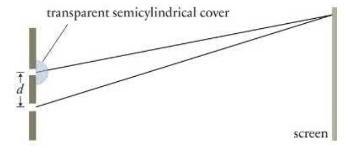In experiment 1 , a laser beam of (750-mathrm{nm}) light is passed through a double-slit barrier and
Question:
In experiment 1 , a laser beam of \(750-\mathrm{nm}\) light is passed through a double-slit barrier and creates a diffraction pattern on a screen. In experiment 2 , one slit is covered with a semicylindrical piece of material that has an index of refraction of \(n=1.001\), as shown in Figure P34.117, and the \(750-\mathrm{nm}\) beam again passes through and creates a diffraction pattern on the screen. If the distance between the slits is \(d=1.2 \mathrm{~mm}\), what is the smallest radius of the semicylindrical piece that results in the screen locations that were bright fringes in experiment 1 being dark fringes in experiment 2, and the screen locations that were dark fringes in experiment 1 being bright fringes in experiment 2 ?
Data from Figure P34.117

Step by Step Answer:






